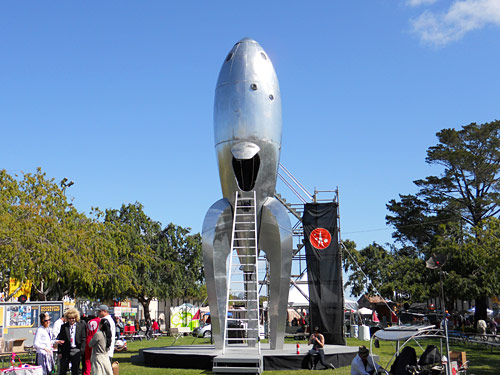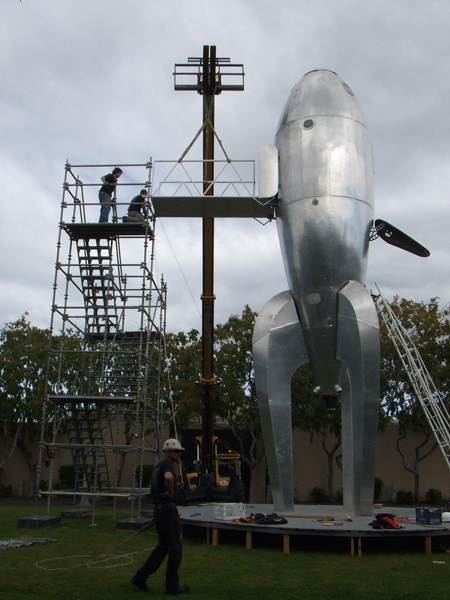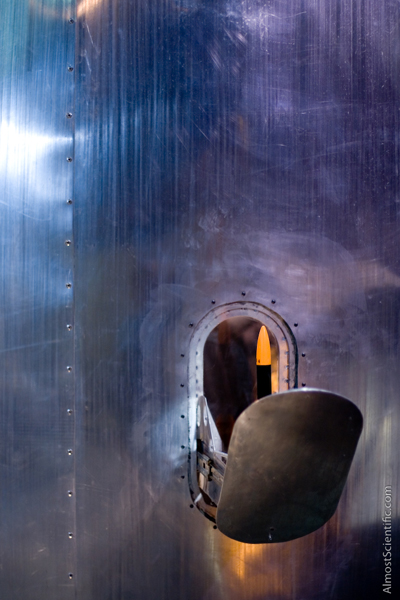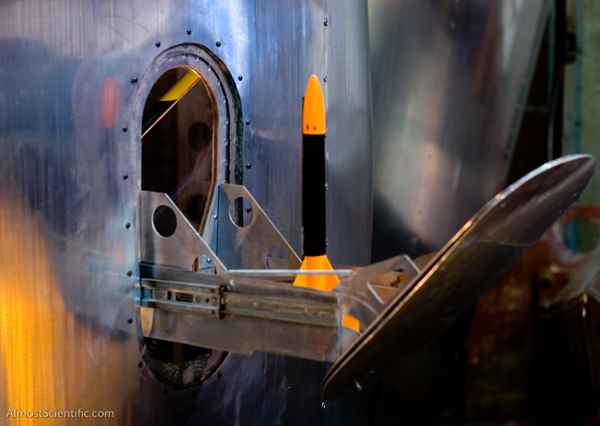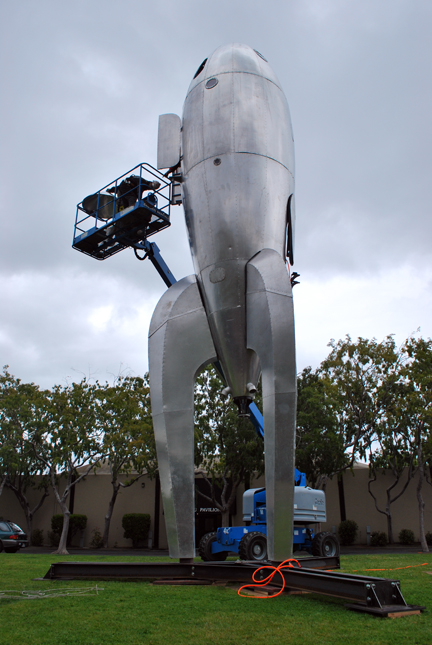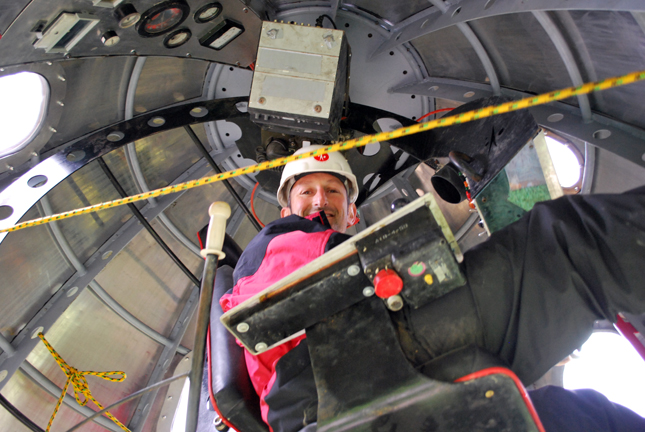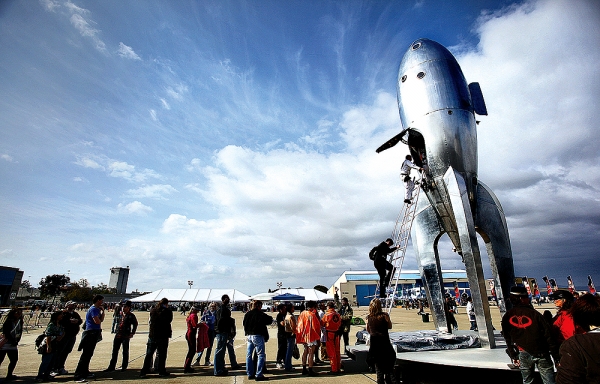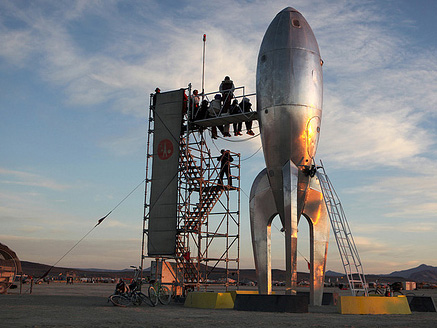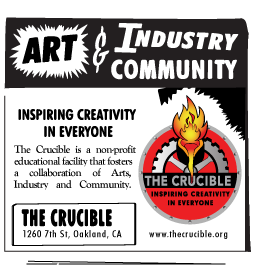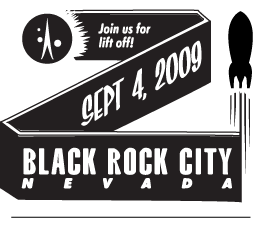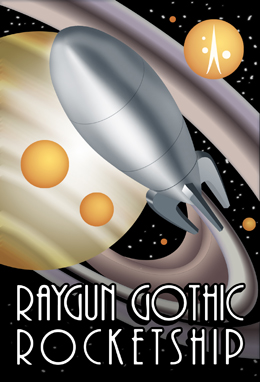Archive for the ‘Press & Publicity’ Category
Pictures of the Raygun Gothic Rocketship on Popularmechanics.com
Tuesday, May 25th, 2010Robots and Rockets: Mashable highlights at Maker Faire
Monday, May 24th, 2010The Road to Maker Faire: How to Launch a rocket!
Friday, May 21st, 2010The Raygun Gothic Rocketship has been successfully installed and is “standing by,” ready for the 2010 Makers Faire weekend. Our gantry tower has been erected and the explosive bolts on the escape hatch are armed!
We are all systems go…!
The RGR is more than just a shiny outer hull… and so we wanted to give you a brief glimpse of what you’ll find inside. To begin, here’s a post by one of the lead artists on the RGR project, David Shulman, talking about our deployable on-board rocket (probe)launcher.
SeanO
How to Launch a Rocket… from a Raygun Gothic Rocketship
by David Shulman
Every rocketship needs a rocket launcher, right?! In case you want to launch a probe? Or need to fire a space torpedo? Since my friends and I were already building a rocketship, I decided that we needed to build a rocket launcher too. The fact that I’ve never built a kinetic mechanism before should not be a deterrent, right?! I thought long and hard about what qualities it should have. Something that can be activated from inside; a launch platform that deploys from the side of the ship; a clear blast shield that allows you to witness the launch, and a mirrored outer hull cover that lets you follow the ascent. My friend John Hollis and I started to scheme.
The first iteration was a temporary success; driven by a linear actuator following a curved path and operating a lever, it extended an aluminum tray out of the body of the main ship, and electrically fired an Estes rocket. I said it was a temporary success, because after five days of use, it failed (granted, it was Burningman) – the actuator ceased to function, although the firing mechanism still worked. (We could, and therefore did, continue to launch rockets for several more days.)
We got back to the shop, only to discover that the actuator was fine – a simple toggle switch had suffered an internal failure. No matter – the Mark II was destined to be better, anyway. We planned to swap the linear actuator for a rack and pinion gear, as it would reduce the space needed, which on a spaceship is always helpful.
The Mark II.a (reployed at Yuri’s Night, at NASA Ames Research Center) worked OK, but we found that the rack and pinion actually needed to be perfectly aligned and spaced to work smoothly. Who would’ve thought?! With the Mark II.b (this weekend’s Maker Faire), we added limit switches, to stop the motor when the tray hit the end of its travel, to prevent burn out.
In the shop, it all worked – we tested it thoroughly, and found no problems after a dozen cycles. Imagine my consternation when, trying to test-launch a probe to measure wind direction on the midway yesterday. — it didn’t work! I toggled “extend” and it would not go. But when I tried “retract,” I had no problem?
I could not figure it out. Everything checked out, there were no shorts, (other than the ones I inadvertently caused ), all the switches were working, but I could not find the problem.
Finally, I thought to check the default on the limit switches. Sure enough, the outer limit switch was wired backwards! I have no idea how we tested successfully in the shop – but at 5:30 PM on Wednesday of set-up week – I had it! It went something like this:
- Estes Alpha II, with an A6-3 engine, racked and ready for launch.
- Deploy the launch assembly.
- Arm the ignition system.
- Ask a passerby to tell me (from outside the ship) which direction my probe goes.
- 3, 2, 1…
- Launch!
And the results?
The good news: a successful test launch!
The bad news.: an offering to the rocket gods.
(If you find the lost rocket, or any other we might launch over the weekend, bring it back to us, and come straight to the head of the line! Or, if you can explain what allowed us to test successfully in the shop, then find a problem in the field, you get to launch one!)
The Road to Maker Faire: Greetings Earthlings!
Tuesday, May 18th, 2010The Raygun Gothic Rocketship and her crew arrived in San Mateo, Earth today, on the 17th day of the 5th month in the year 2010. After an uneventful 12-hour trans-galactic journey across the western reaches of the Sobay Nebula, our sturdy and resilient little ship finally settled down on the grassy planetary landscape that will soon be densely populated by the rare and interesting Humanus Makeriferous Species. We look forward to studying their kind…
The RGR Crew will be docked for approximately seven Earth days in order to take on supplies, refresh our reading material, and to grant shore leave to the crew. Ship tours will commence on the day of the Saturn and will continue until the moon rises on the day of the Sun.
To all you Space Cadets out there! The RGR Crew is recruiting! Stop by our space port and pick up a Raygun Gothic Rocketeer recruitment packet today!
Follow the exploits of the RGR Crew on the The road to Maker Faire on Make: Online
RGR Lead Artists interviewed for the Make Blog
Thursday, April 29th, 2010MFBA: Interview with Raygun Gothic Rocketship crew

Maker Faire Bay Area, the world’s largest DIY festival, is right around the corner, taking place at the San Mateo Fairgrounds on May 22nd and 23rd. One of the biggest new projects coming to the Faire this year is the Raygun Gothic Rocketship, pictured above and hand-crafted by a large and dedicated crew. We sent seven questions to the crew’s three lead artists, Sean Orlando, Nathaniel Taylor, and David Shulman. Here’s what they had to say.
1. Tell us about the project you’re bringing to Maker Faire.
The Raygun Gothic Rocketship is built upon a future-rustic vision of yesterday’s tomorrow. Aesthetically based on 1930s – early 1950s science fiction, the rocketship is a 41-foot-tall immersive environment, designed to carry explorers into the realm of rayguns, strange planets, and aliens, friendly or otherwise.

With 3 habitable decks, visitors can view and interact with a variety of ships systems and alien specimens. Visitors can enter the ship via the Engine Room & Life-Sciences Bio Lab. Once inside the engine room, look down into the engine compartment to see The Uira Plasma-drive engine. Cases and cages on the walls contain various creatures we’ve collected in our travels. Check on the ships status with the Systems Monitor, or speak to the Pilot via the tele-com.

Moving up a deck, you’ll find Crew Quarters, Navigation, Communications & Remote Sensing. Check our approach trajectories using the Neutronium Scanner, confirm our location using one of several navigational devices, or deploy a remote probe via the Hollis 9000 Remote Science System. Finally, you can climb up to the flight deck and pilots chair. Take command of the ship and prepare for launch!
2. How did you hear about Maker Faire and why did you decide to participate?
As a group, we have been fans of or involved with the Maker movement and Maker Faire for many years. Many of our crew have shown other works, both large and small, at past MAKE events in association with such groups as The Crucible, Applied Kinetic Arts, Kinetic Steam Works, and SRL.
3. Tell us about yourself. How did you get started making things and who are your inspirations?
The three of us all have different stories.

David Shulman: I began making things with my father as a kid — mostly simple furniture. He inspired me in that he was an attorney, yet was not afraid to get his hands dirty, or try new things, and I have followed a similar path.

Sean Orlando: I’ve been tinkering and inventing for as long as I can remember. Creating three-dimensional artworks resonated with me more than any of the other art practice that I experimented with. My father was an aerospace engineer and exposed me to airplane and rocket engineering at an early age. The engineering challenges, collaborative creative process, and immersive potential of large-scale installations allowed me to explore a whole new level of art making… with friends.

Nathaniel Taylor: Nathaniel was born with a tool in his hands. He is the Chief Operating Officer and creative mind behind Radio Robot.
4. Is your project strictly a hobby or a budding business? Does it relate to your day job?
Our project is both. Through the RGR and past projects (such as the Steampunk Tree House), we are exploring the concept of cooperative art as both a focus for creative community, and an opportunity to generate income for our member artists. The Five Ton Crane Arts Group was formed as a direct result of these successful collaborations.
5. What new idea (in or outside of your field) has excited you most recently?
We are constantly inspired and motivated by artistic invention, clever engineering solutions, and creative collaboration. We strive to create immersive environments that combine sculpture, kinetics, performance, interactivity, and creative collaboration. It’s exciting to see the latest inventions coming out of Europe by such groups as Royal de Luxe and La Machine.
6. What is your motto?
“Art is better with friends.”
“We aim to be rather than to seem.”
“Just because it hasn’t been done before, doesn’t mean it can’t be done.”
7. What advice would you give to the young makers out there just getting started?
Just do it. Don’t hesitate for fear of challenge or failure. Don’t get caught up in what “seems” to be impossible. Just because it hasn’t been done before, doesn’t mean it can’t be done. The benefits of your realized ideas are not only experienced in the end result of your experiments. There is so much fun to also be had through the process of invention, creative problem solving, overcoming challenges, and working together as a team.
Thanks, gentlemen, words of widsom for sure! We’re excited to see the Rocketship in its full glory at Maker Faire. You can still get discounted tickets until May 12. For all the information you need, head over to the Maker Faire website.
RGR featured on the cover of the Mountain View Post
Friday, April 16th, 2010Moffett a space-age playground for ‘Yuri’s Night’
Stunt planes, hip-hop, crazy art and more mark NASA celebration in honor of Russian cosmonaut
NBC Bay Area: The Raygun Gothic Rocketship at NASA Ames for Yuri’s Night
Tuesday, April 13th, 2010The Rocketship was a huge hit at this weekend’s Yuri’s Night Festival at the NASA Ames Research Center ion Mountain View California.
First press is coming in now…check it out!
The Raygun Gothic Rocketship featured on the 2010 Maker Faire poster
Friday, April 2nd, 2010
A Note from NASA
Thursday, April 1st, 2010Following our return from the Burningman event, the RGR crew received a message from an unexpected, yet very exciting source – NASA itself. We were thrilled at the inquiry, being long-time supporters of space exploration and NASA’s mission.
What followed were a series of conversations about possible exhibition collaborations, and eventually a site visit by a distinguished member of the NASA team.
We are proud, humbled and thankful to have received the following letter of support for our project, and are pleased to share it with all of our supporters:
January 27, 2010 via email
I’d like to express my support for the efforts and accomplishments of the team that built the Raygun Gothic Rocket.
I personally met with the team and viewed the rocket during a recent trip to California. At the NASA, Johnson Space Center we are very interested in promoting new and unique ways of engaging young people in the excitement and thrill of flying humans in space. We believe generating a passion for spaceflight directly translates into more students pursuing careers in science, technology, engineering and math.
I believe the Raygun Gothic Rocket team uniquely captured the emotion and wonderment each kid has felt with space travel at some time in their childhood. In fact, their creation stirs the child in each of us as we remember those emotions and why we feel that continued support for developing advanced technologies that push the boundaries of human knowledge and capability is essential.
I applaud the team for tapping that emotion in a unique and creative way. I believe it has the potential to make a personal and significant impact to each who encounter it.
Joel Walker
Director, Center Operations
NASA Johnson Space Center
Houston, Texas
Also Chairman of the Board for the Manned Spaceflight Education Foundation which operates Johnson Space Centers official visitor center, Space Center Houston.
The Raygun Gothic Rocketship featured on the NASA Ames website
Friday, March 26th, 2010Click HERE for the full story
A 40-foot high rocket from the future and a 20-foot tall bird with its head and wings on fire will light up on Saturday, April 10, 2010 at NASA Ames Research Center, Moffett Field, Calif. Is this a science experiment gone awry? No, it’s all part of Yuri’s Night.
Yuri’s Night is a world space party that commemorates the anniversary of the first human spaceflight, by Russian cosmonaut Yuri Gagarin on April 12, 1961 and the first space shuttle mission 20 years later. An estimated 10,000 people are expected to attend the Bay Area celebration from noon to midnight.
During this “mash-up” of music, dance, technology, art and space, two large-scale art installations that previously have been exhibited at the Burning Man Festival will be displayed: the “Raygun Gothic Rocketship” and “Angel of the Apocalypse.”
What these two giant sculptures share in common is that they both were built by dozens of team members collectively working together.
Sean Orlando, one of three lead artists for “Raygun Gothic Rocketship,” said the effort required the work of 85 artists, engineers, fabricators, scientists and computer engineers. “One of the remarkable things about this group of people is how few issues there are,” said Orlando. “When it comes to actual work and the design process, it truly is very collaborative.”
The retro-futuristic rocket stands four stories high, weighs 3,500 pounds and requires a crane with a 40-foot, 5-ton installation capability. The structure is divided into three sections: a life sciences bio lab, engineering room, crew quarters and a command module. Interior details include “alien specimens” in the life sciences bio lab, a zero gravity bed and a deployable rocket launcher.
“We’re sci-fi geeks who like to play with machines and tools,” said lead artist David Shulman. “Our inspiration was from the 1930s through early 1950s when technology was within sight, but the reality of what it would entail or the Cold War pessimism had not set in yet.”
The term, “Raygun Gothic” is an artistic style coined by science fiction author William Gibson. Orlando said the name refers to how people in the past imagined the future.
“We’re thrilled to be able to bring it to a NASA facility and share it with people who are interested in space exploration—both the serious side and the fun side,” said Orlando.
Click HERE for the full story

